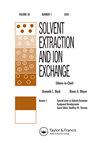Adsorptive Removal of Selenium(IV) from Aqueous Solution by Ferrous Hydroxide Complex-Zero Nickel Composites
IF 2.1
4区 化学
Q3 CHEMISTRY, MULTIDISCIPLINARY
引用次数: 1
Abstract
ABSTRACT Nanoscale ferrous hydroxide complex-zero nickel composites (FHC/Ni0) were fabricated by ball milling method for Se(IV) adsorption from aqueous solution. The effects of pH, solid-liquid ratio, time, temperature, initial concentration of Se(IV) on the adsorption of Se(IV) by FHC/Ni0 were investigated. FHC/Ni0 was characterized by SEM, XPS, XRD, FT-IR, BET and Zeta potential, and the mechanism of removing Se(IV) was analyzed. The results showed that FHC/Ni0 had a good removal effect on Se(IV). When pH was 5.0, the solid-liquid ratio was 0.15 g L−1, the reaction time was 40 min, the maximum adsorption capacity of Se(IV) by FHC/Ni0 could reach 216 mg g−1. The pseudo-second-order kinetic model and Langmuir had a good fit for the Se(IV) adsorption process of FHC/Ni0, indicating that the monolayer and chemical adsorption played a leading role in the adsorption process. XPS analysis further confirmed that the adsorption of Se on FHC/Ni0 was mainly due to the formation of stable complexes with a large number of functional groups containing Fe, Ni and S, meanwhile, the removal of Se(IV) by the material is achieved through a combination of chemical adsorption and reduction reactions. The research results can demonstrate the feasibility of FHC/Ni0 in Se(IV) removal and provide a theoretical basis for the treatment of wastewater containing Se(IV).氢氧化亚铁络合物-零镍复合材料吸附去除水溶液中的硒(IV)
采用球磨法制备了纳米级氢氧化铁-零镍复合材料(FHC/Ni0),并对Se(IV)进行了吸附。考察了pH、料液比、时间、温度、初始浓度对FHC/Ni0吸附Se(IV)的影响。采用SEM、XPS、XRD、FT-IR、BET和Zeta电位对FHC/Ni0进行了表征,并对其去除Se(IV)的机理进行了分析。结果表明,FHC/Ni0对Se(IV)有较好的去除效果。当pH = 5.0,料液比为0.15 g L−1,反应时间为40 min时,FHC/Ni0对Se(IV)的最大吸附量可达216 mg g−1。拟二级动力学模型和Langmuir对FHC/Ni0的Se(IV)吸附过程拟合较好,说明在吸附过程中,单层吸附和化学吸附起主导作用。XPS分析进一步证实了Se在FHC/Ni0上的吸附主要是由于与大量含Fe、Ni和S的官能团形成稳定的配合物,同时材料对Se(IV)的去除是通过化学吸附和还原反应相结合的方式实现的。研究结果验证了FHC/Ni0去除Se(IV)的可行性,为含Se废水的处理提供了理论依据。
本文章由计算机程序翻译,如有差异,请以英文原文为准。
求助全文
约1分钟内获得全文
求助全文
来源期刊
CiteScore
4.40
自引率
5.00%
发文量
15
审稿时长
8.4 months
期刊介绍:
Solvent Extraction and Ion Exchange is an international journal that publishes original research papers, reviews, and notes that address all aspects of solvent extraction, ion exchange, and closely related methods involving, for example, liquid membranes, extraction chromatography, supercritical fluids, ionic liquids, microfluidics, and adsorption. We welcome submissions that look at: The underlying principles in solvent extraction and ion exchange; Solvent extraction and ion exchange process development; New materials or reagents, their syntheses and properties; Computational methods of molecular design and simulation; Advances in equipment, fluid dynamics, and engineering; Interfacial phenomena, kinetics, and coalescence; Spectroscopic and diffraction analysis of structure and dynamics; Host-guest chemistry, ion receptors, and molecular recognition.

 求助内容:
求助内容: 应助结果提醒方式:
应助结果提醒方式:


